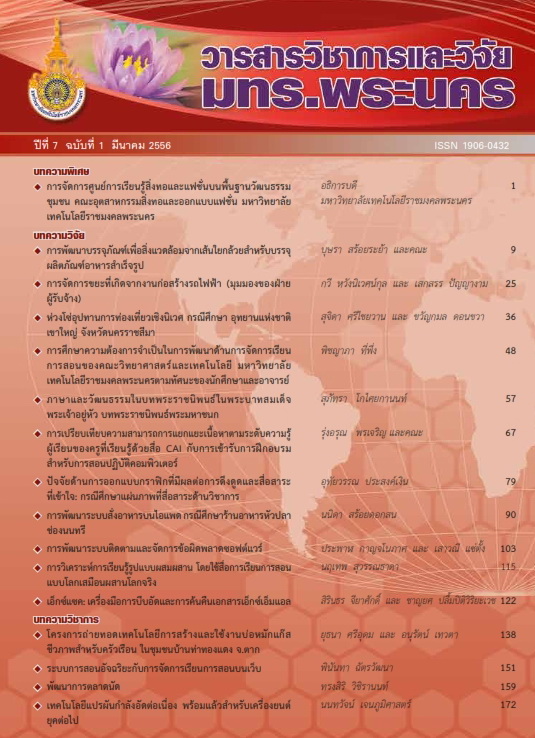พัฒนาการตลาดนัด
Main Article Content
Abstract
บทคัดย่อ
การศึกษาครั้งนี้มีวัตถุประสงค์เพื่อศึกษาพัฒนาการของตลาดนัดของไทยตั้งแต่สุโขทัยเป็นราชธานีถึงปัจจุบัน โดยศึกษาจากหนังสือ บทความ งานวิจัย รวมถึงเอกสารที่เกี่ยวกับตลาดและตลาดนัด ทั้งนี้ได้แบ่งพัฒนาการของตลาดนัดเป็น 2 ลักษณะ ลักษณะแรกใช้ลำดับของช่วงเวลาเป็นเกณฑ์ แบ่งได้เป็น 4 ช่วงได้แก่ ช่วงที่ 1 ตลาดปสานถึงตลาดนัดสนามหลวง ช่วงที่ 2 ตลาดนัดสนามหลวง ช่วงที่ 3 ตลาดนัดจตุจักร และช่วงที่ 4 ตลาดนัดหลังวิกฤตเศรษฐกิจปี 2540 ส่วนลักษณะที่สองแบ่งโดยใช้รูปแบบวิถีชุมชน แบ่งเป็น 3 รูปแบบ ได้แก่ 1.วิถีชุมชนกับลักษณะกายภาพ 2. วิถีชุมชนเมือง : ความสัมพันธ์ตลาดสดกับตลาดนัด และ3. ตลาดนัดถนนคนเดิน
Abstract
This research aimed at exploring the development of Thai flea markets from the Kingdom of Sukhothai to the present. Data collection was implemented by books, articles, researches including market and flea market documents. The development of Thai flea markets was classified into two categories: interval sequence and community lifestyle. Interval sequence was divided into four parts: 1) from Pa-Sarn market to Sanamluang market, 2) Sanamluang market, 3) Jatujak market and 4) markets after the economic crisis in 1997. Community lifestyle was divided into three parts: 1) lifestyle and physical evidence, 2) city community lifestyle: the relationship between fresh markets and flea markets and 3) walking street markets.
การศึกษาครั้งนี้มีวัตถุประสงค์เพื่อศึกษาพัฒนาการของตลาดนัดของไทยตั้งแต่สุโขทัยเป็นราชธานีถึงปัจจุบัน โดยศึกษาจากหนังสือ บทความ งานวิจัย รวมถึงเอกสารที่เกี่ยวกับตลาดและตลาดนัด ทั้งนี้ได้แบ่งพัฒนาการของตลาดนัดเป็น 2 ลักษณะ ลักษณะแรกใช้ลำดับของช่วงเวลาเป็นเกณฑ์ แบ่งได้เป็น 4 ช่วงได้แก่ ช่วงที่ 1 ตลาดปสานถึงตลาดนัดสนามหลวง ช่วงที่ 2 ตลาดนัดสนามหลวง ช่วงที่ 3 ตลาดนัดจตุจักร และช่วงที่ 4 ตลาดนัดหลังวิกฤตเศรษฐกิจปี 2540 ส่วนลักษณะที่สองแบ่งโดยใช้รูปแบบวิถีชุมชน แบ่งเป็น 3 รูปแบบ ได้แก่ 1.วิถีชุมชนกับลักษณะกายภาพ 2. วิถีชุมชนเมือง : ความสัมพันธ์ตลาดสดกับตลาดนัด และ3. ตลาดนัดถนนคนเดิน
Abstract
This research aimed at exploring the development of Thai flea markets from the Kingdom of Sukhothai to the present. Data collection was implemented by books, articles, researches including market and flea market documents. The development of Thai flea markets was classified into two categories: interval sequence and community lifestyle. Interval sequence was divided into four parts: 1) from Pa-Sarn market to Sanamluang market, 2) Sanamluang market, 3) Jatujak market and 4) markets after the economic crisis in 1997. Community lifestyle was divided into three parts: 1) lifestyle and physical evidence, 2) city community lifestyle: the relationship between fresh markets and flea markets and 3) walking street markets.
Article Details
How to Cite
[1]
วิชิรานนท์ ท., “พัฒนาการตลาดนัด”, RMUTP Sci J, vol. 7, no. 1, pp. 159–171, Mar. 2014.
Section
บทความวิชาการ (Academic Articles)
ลิขสิทธ์ ของมหาวิทยาลัยเทคโนโลยีราชมงคลพระนคร


